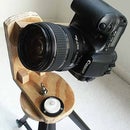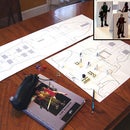Introduction: How to Clean a Laptop Screen With Household Products
If you are like me, your laptop screen gets dirty, smeared, gunky, and full of fingerprints. And thats not even all.
But how to clean it without ruining your laptop? Surely there is something in your home that can clean it properly and wont damage the screen.
Yes there is, and this instructable will show you what to use.
Step 1: What You Need
- Vinegar or Isopropyl alcohol (Rubbing alcohol) (I am using Isopropyl Alcohol, but the mixture amounts are the same for them both)
- Distilled water
- A soft cotton cloth (a terry towel)
- 1 bottle sprayer
NEVER drink isopropyl alcohol. You will get sick and have to have your stomach pumped or have activated charcoal administered.
Do not use paper towels, they are made with wood fiber and can scratch the LCD screen. Not even 100% Recycled. Just Dont.
Avoid using products such as Windex because these contain ammonia and it can degrade the LCD panel.
Using a lint-free microfiber cloth is best, an "old T-shirt" or other soft cloth can introduce dust and lint which may be detrimental to the computer itself.
If in doubt, test a small area of screen first.
Step 2: Make the Solution
Dilute isopropyl alcohol (not rubbing alcohol, as it may contain oil) into a solution that is 50% alcohol and 50% with distilled water / deionised water, or there abouts. You want them to be even. Purified / bottled water works well too.
You dont want to have any mineral markings show up on your screen, so make sure you use the right water.
If you remember from the first step (picture will be below again) the isopropyl that I am using is 70% by volume, which means its 30% water. So you want to make sure to only add 20% water to the solution.
Your isopropyl will vary, but its normally sold at 70% and 91% (add 20% water or 41% water). You dont have to be too perfect with the amounts, but as close as possible is best.
If you want to get 99.9% isopropyl alcohol so that you can do the 50/50 yourself easier, please look at How to "Salt Out" by member thinkahead.
Step 3: Mixing
Put the solution in a small spray bottle.
DO NOT spray on the screen itself.
Step 4: Applying
Apply the solution to a cotton cloth, such as an old T-shirt, lint-free microfiber cloth, or other very soft cloth.
Just not a paper towel, anything abrasive, or overly linty.
A large cloth is best, since it will help to reduce the risk of leaving streaks across the screen from finger pressure.
Step 5: Turn Off the Laptop
Shut down your laptop, unplug it from the power adapter, and remove the battery before cleaning it or you can risk damaging the pixels in the LCD display.
You dont need a picture for this step I hope.
Step 6: Cleaning
Wipe the cloth with the cleaner along the screen, making sure to get along the sides and in the corners. If you press to hard, you risk damaging the screen. You dont want to do that.
You can see below the using and wiping of the cloth and the dirty screens of my two laptops, as well as how well this works.
Step 7: Tips
Helpful Tips on this subject
- Plastic and glass cleaners containing ammonia may leave a glare-causing film.
- Expensive store-bought products contain the same mixture of alcohol and water. Others include Ethylene Glycol. You really do not need all these additions, which may be harmful to your health and to the environment.
- If you apply too much of the solution and it is drippy or too damp, wipe it off with a soft cloth and apply less.
- Tissues, napkins, and other paper products will leave flakes of paper on your monitor. It's better to not even try using them. They may even scratch polished surfaces.
- You don't want mineral spots on your screen, so don't use tap water.
- Using a 100% cotton cloth or shirt alone, without the alcohol mix, can sometimes produce the same smudge-free results without going to the trouble of mixing your own solution.
- If you're a photographer, you can use your lint-free lens wipes instead of a soft cotton cloth.
- If you are looking for a cheap way to get your hands on ready-made cleaning solution, try CD/DVD cleaner, which is often 55% Isopropyl alcohol and is not harmful to most plastic surfaces.
- Lint free cotton cloth will work best.
- If you are the owner of a lacquered instrument you can use a dry polishing cloth. You have to use a bit more force with dried on spots, but with smudges it works just fine.
- If you have lens cleaner for eyeglasses, check the back to see if it contains "Isopropanol" as it should work just as well, and may already come in the proper spray bottle.
- I have heard that IBM laptops have a drain built into the sealed keyboard tray. They recommend pouring water in the keyboard to further drain any sticky liquids (coffee, pop, etc) and just letting it air-dry. I dont know about this at all, but if you try it, plan to set time aside to clean your laptop computer so that you will not be rushed and can do a thorough job. Rushing through cleaning your laptop computer will lead to problems and potential for damage to your laptop computer. You should do a complete cleaning of your laptop on a regular basis to keep it running properly.
From killerjackalope
- Another source of lint free cloths is the one that comes with plasma TVs it's the same kind of clother used for lenses and whatnot, for some reason you're not supposed to touch the actual screen and water is only safe but should only be used when necessary, damage will occur otherwise, bottom line the cloth you get is safe for LCDs if you have a glass fronted LCD you have less to worry about though.













